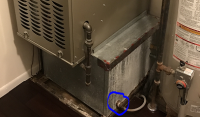Pardon my ignorance on this. It appears to me that the fitting in the blue that i circled is the condensate drain for the pan. Is there a reason as to why this fitting is metal? It looks rusted. Everything i have seen generally shows a drain fitting as PVC. I also noticed that the barbed fitting connects what seems to be a very small ID vinyl tube that just runs into my crawl space.
I never inspected to ensure that it was draining during operation. Should i replace the metal fitting and put in a bigger ID tube for better draining? My concern is that if that is the main drain, than it is located extremely close to the floor and dont thing i could properly route PVC to an appropriate drain such as a condensate pump given the height restrictions.
I never inspected to ensure that it was draining during operation. Should i replace the metal fitting and put in a bigger ID tube for better draining? My concern is that if that is the main drain, than it is located extremely close to the floor and dont thing i could properly route PVC to an appropriate drain such as a condensate pump given the height restrictions.

